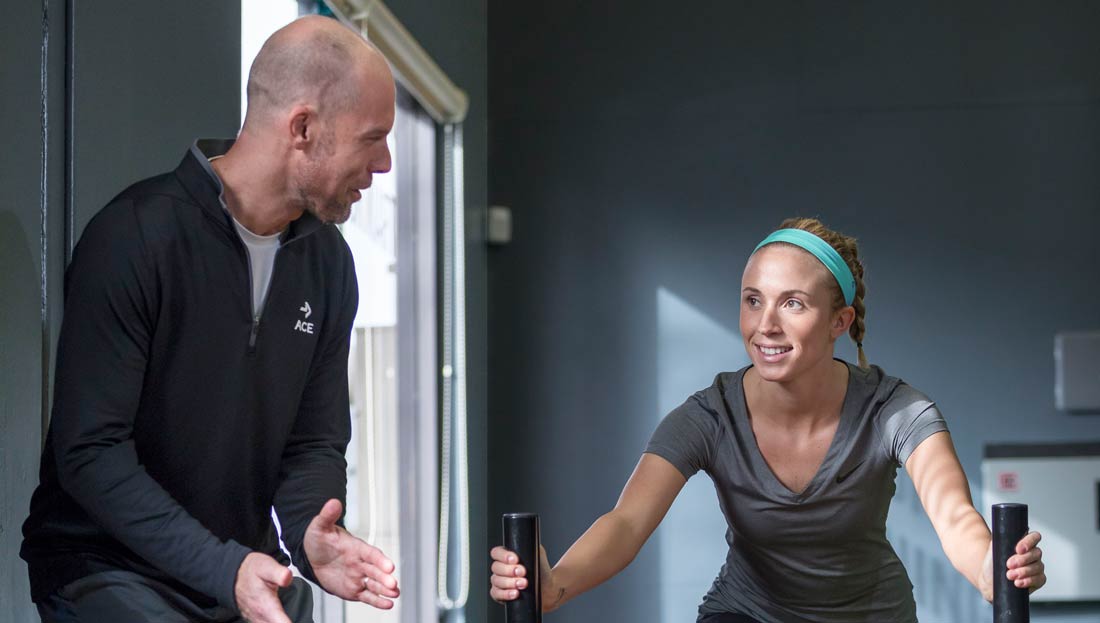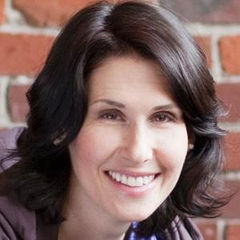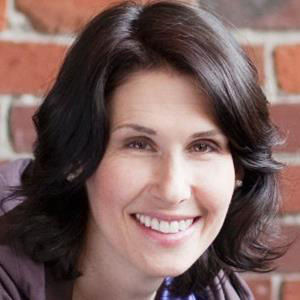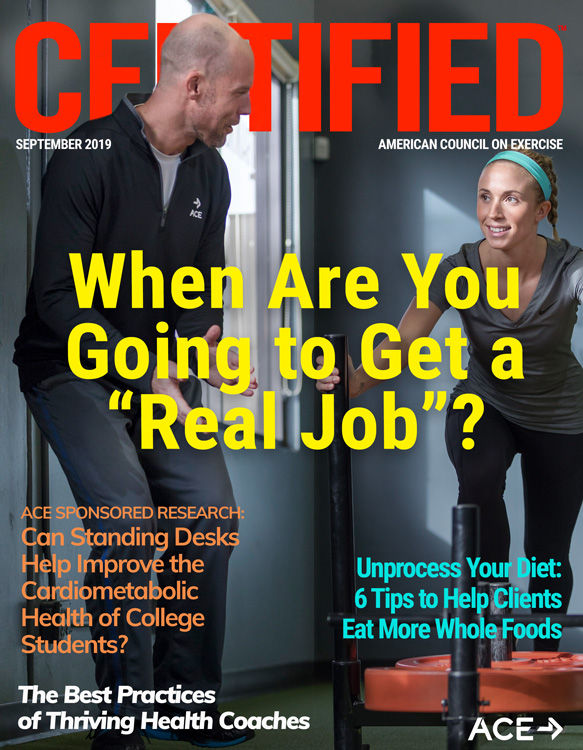
Has anyone ever asked you when you plan to get a “real job” or assumed that what you do in the fitness industry is a hobby or passing phase? Why is it so problematic for people to acknowledge supporting people who are in the pursuit of fitness as an actual profession? After all, we help people in enormously impactful and positive ways. Let’s explore why some folks (perhaps a few well-meaning family or friends?) don’t always see exercise instruction and personal training as a real job. Fortunately, there are tactics to turn this misperception around.
The Perception That Fitness Isn’t a “Real Job”
Opinions about developing and leading exercise programs as a not-so-serious pursuit might have taken shape when the industry was new.
“The perception was that teaching was more like a hobby for instructors and that fitness classes were a bit silly: jumping around, loud music, bright lights and a super-motivated instructor,” says Fred Hoffman, M.Ed, Paris, France−based owner of Fitness Resources Consulting and a member of the ACE Board of Directors. “Even though the industry has definitely made some gains in perception, those stereotypes still exist.”
Working 9 to 5 (or Not)
As we overcome past impressions, modern-day instructors and trainers still get hassled about not having a real job. It’s as if any workday that doesn’t require you to sit behind a desk from morning to late afternoon is suspect.
“A lot of our non-training work is done on our phones, at home offices, at home, etc.,” says Angie Burgin, owner of Purestuff Wellness in Seattle, Wash. “People do not see the hours of communication and planning we do for classes and our clients outside of the gym.”
And when health and exercise professionals aren’t busy behind the scenes, they might appear as if they aren’t getting much work done.
“Often people see us in class or with clients at the gym having a good time,” says Burgin. “Even when we are hanging out, chatting with members or clients (typically not getting paid!), people may be envious or think we are just having fun. But it’s also a part of the sales aspect of our job.”
“Outside the industry, people only see the instructor or personal trainer ‘working’ for one hour at a time,” says Matthew Taub, a personal trainer and regional fitness manager for Orangetheory Fitness in Toronto, Ontario. “A real job to most people resonates as 9 to 5,” he says. “A fitness pro can work from 5:00 a.m. to 10:00 a.m. and then not have another client until 4:00 p.m. These hours are not ‘professional’ hours, so it’s not seen as real.”
Lack of Regulation
But there are still plenty of widely accepted occupations—such as firefighter, police officer and surgeon—that don’t follow the 9-to-5, behind-a-desk formula. So, what’s the difference? Industry regulation likely plays a part. It’s possible to pass as a trainer or instructor on social media or in some gyms without relevant credentials or education.
“Unlike many professions where regulation is tight—like in healthcare and education (which, in my mind, are all related fields)—the fitness community at large has not mandated that instructors and trainers hold that level of certification to get hired,” says Mindy Pedersen, a master trainer, group fitness instructor and Regional Head Trainer for Orangetheory Fitness Washington in Seattle.
“We are not a ‘board certified’ profession,” adds Myrna Brady, a personal trainer for more than 18 years and Proactive Health Care Specialist in Hartsdale, N.Y. “Anyone can call themselves a personal trainer or group instructor.”
While government regulation may not exist, ACE and other top certification organizations in the fitness industry have earned third-party accreditation from the National Commission for Certifying Agencies (NCCA) for their certification programs for exercise professionals. The NCCA has reviewed and accredited the certification programs for most professions in healthcare, including nurse practitioners, registered dietitians, occupational therapists, physician assistants, athletic trainers, medical assistants and exercise professional certifications from more than a dozen organizations. By earning NCCA accreditation for their certification programs, these organizations have taken the professional and responsible steps necessary to help position well-qualified exercise professionals as legitimate members of the healthcare continuum.
Pay Standards
But there’s another, probably related, contributing factor, and that’s industry pay standards.
“Many trainers and instructors are hourly employees with little-to-no benefits,” says Pedersen. “This pay structure often leaves [health and exercise professionals] needing second jobs that have benefits or a salary in order to be more stable and sustaining.” Some independent contractors face similar issues.
Moreover, job growth might be slower than what trainers and instructors anticipate, partly due to stagnant wages among gym employees. According to the International Health, Racquet & Sportsclub Association’s (IHRSA’s) 2018 U.S. Fitness Professional Outlook, the median hourly wage for personal trainers was $21.50 in 2003 and $30 in 2016. Even with this increase over 13 years, health-club employees might wish for faster salary growth. For example, the same IHRSA 2018 report indicates that full-time trainers were paid $25 per hour in 2007. Fast-forward 10 years and we see that full-time trainers averaged $30 per hour (or about $24 per hour for part-time) in 2017 (IHRSA, 2018). (Note: This timeframe includes a deep decrease in wages around 2012–2013 as a result of economic recession.) At the same time, health-club membership grew by 33.6% in approximately the same time span, elevating industry revenue to $87.2 billion last year (IHRSA, 2018).
To top it off, full-time training or instructing isn’t always desirable or feasible.
“Because the job role is extremely physically demanding in most cases (e.g., doing the workout with members, demonstrating proper movements and options, moving heavy weights and equipment),” says Pedersen, “doing this type of job full time is difficult unless it is coupled with other roles such as sales associate, manager, etc. Due to these roles not being considered a traditional full-time job, they are not given a ‘real job’ status.”
Mixed Messages
 Finally, the industry tends to put out mixed messages about its professionalism—consumers viewing traditional and social media might question whether personal trainers are dedicated professionals (or at least wonder how to spot those who are). Hoffman says some health and exercise professionals do themselves a disservice by focusing only on the physical side of what they do.
Finally, the industry tends to put out mixed messages about its professionalism—consumers viewing traditional and social media might question whether personal trainers are dedicated professionals (or at least wonder how to spot those who are). Hoffman says some health and exercise professionals do themselves a disservice by focusing only on the physical side of what they do.
“Social media has amplified this,” says Hoffman, “with fitness pros posting photos of themselves in skimpy or revealing clothes (men and women alike), as well as many promoting themselves as fitness gurus when they don’t really have the credentials to back it up. As a result, a lot of the general public just doesn’t see them as serious professionals.”
So, it seems public opinion might be working against us. However, as a health and exercise professional, you have the power to flip false perceptions. Keep reading for ideas on how to respond to insinuations that you’re dabbling in fitness just for fun or as a side gig. More importantly, consider how the attitudes of health and exercise professionals might either perpetuate or counteract the real-job myth.
What Fitness Pros Can Do to Elevate Perceptions
With so many start-ups, small businesses and entrepreneurs in today’s marketplace (not just in fitness), the 9-to-5 status quo is outdated. And because there is no playbook about how to have a fitness job, your role might be more innovative than you give it credit for.
“On ‘bring your kid to work’ day, I had parents calling because their kid wanted to go to my work,” says Taub. “Not because it was an easy day (it started at 4:00 a.m.), but because my 14-year-old raves about what I do. So, it seemed like a better job for the kids to see than going to an office. It’s how we position it as fitness pros that makes the difference.”
Educate Naysayers About What You Do
Positioning is important. If anyone questions the seriousness of your job, Hoffman advises replying professionally with examples of what you’re doing to change lives.
“Tell people about the movement among fitness pros to work with the medical community and other health professionals, such as nutritionists, physical therapists, etc.,” Hoffman urges.
“I was once asked, after being in fitness for five years or so, what I was going to do when I grew up,” says Taub. Such a question is insulting, of course, but imagine that those looking down on your occupation now might desperately need your services one day. That should shift the dynamic.
Burgin suggests explaining how much time and money health and exercise professionals spend acquiring certifications, continuing education credits and ongoing education. “When people comment about how fun or flexible our jobs are, be honest about some of the challenges,” she says. “I’m guilty of making it sound easy or no big deal when people change schedules or don’t respect my time. Setting boundaries both with clients and with friends is a big part of making them understand this is a real job.”
Passion Alone Won’t Sustain a Career
Above all, manage your own mindset regarding your job’s significance. For example, you might be quite passionate about fitness and helping others—that’s a good thing! Just be sure to emphasize your purpose and value beyond that.
Too many health and exercise professionals get caught in the “we do it because we’re passionate about fitness” trap, which tends to bypass business acumen and underplay fair, even excellent, compensation.
Says Pedersen, “Fitness pros often call themselves out saying, ‘When I grow up and get a real job,’ or ‘I don’t do fitness for the money, but it’s my passion.’ These talk tracks lead them not to be taken seriously by outsiders and undervalued for their skills.”
Furthermore, being passionate about helping others with exercise should never justify unreasonably low or stagnant pay rates.
“Don’t be afraid to charge for your services,” says Brady. “I have learned when I offer complimentary services or discounted prices, people discount me and do not value my time. Present yourself how you would like to be perceived. Act like a professional and not a hobbyist.”
Professional Accountability
Beyond what we can all do on a personal and professional level to elevate perceptions of fitness as a viable career choice, there’s work to be done as an industry.
“I think fitness business owners should require their staff to be certified by a national agency and promote to their membership base that all of their staff is certified,” says Pedersen. There are solid companies, facilities and clients out there that don’t mind paying extra for truly qualified fitness professionals. These are places worth seeking out.
The United States Registry of Exercise Professionals (USREPS) has taken a first step toward industry self-regulation. USREPS provides the fitness industry, healthcare, and the public with a single location where they can verify current certifications held by more than 178,000 well-qualified exercise professionals. To be listed on USREPS, practitioners must hold a current NCCA-accredited exercise professional certification from a member organization of the Coalition for the Registration of Exercise Professionals (CREP).
Reflect Your Worth to Others
“Fitness is a growing industry and we need to make sure we protect it,” says Taub. “When you say you’re a fitness professional, say it with clarity and be proud.”
“Ultimately, fitness professionals control perception,” adds Brady. To that end, by learning how to speak positively and professionally about the role of exercise professionals, you can help advance your role and contribute to raising the bar of the health and fitness industry.
Signs You Have a Real Job in Fitness
How many of the clues in this tongue-in-cheek quiz apply to you?
You have a real job if you:
- Hold a current NCCA-accredited certification as a personal trainer, group fitness instructor or other exercise professional role
- Have successfully completed job-related education provided by an industry leading education and certification organization for exercise professionals (e.g., ACE), or a university degree in exercise science or a related field
- Charge clients/employers money for your services/products/programs
- Are passionate about fitness and helping others but know that passion alone won’t pay bills, so you also pursue proper compensation based on your value
- Sit at a desk or don’t sit at a desk
- Work for eight consecutive hours or work sporadic hours throughout the day and maybe into the evening
- Work full-time or part-time hours
- Could still call yourself a fitness expert even if Instagram disappeared tomorrow
References
International Health, Racquet & Sportsclub Association (2017). IHRSA Health Club Employee Compensation & Benefits Report, 2017.
International Health, Racquet & Sportsclub Association (2018). U.S. Fitness Professional Outlook.
International Health, Racquet & Sportsclub Association (2007). Employee Compensation & Benefits Survey Results for the Commercial Health & Fitness Industry, 2007.





 by
by 

 Finally, the industry tends to put out mixed messages about its professionalism—consumers viewing traditional and social media might question whether personal trainers are dedicated professionals (or at least wonder how to spot those who are). Hoffman says some health and exercise professionals do themselves a disservice by focusing only on the physical side of what they do.
Finally, the industry tends to put out mixed messages about its professionalism—consumers viewing traditional and social media might question whether personal trainers are dedicated professionals (or at least wonder how to spot those who are). Hoffman says some health and exercise professionals do themselves a disservice by focusing only on the physical side of what they do.
